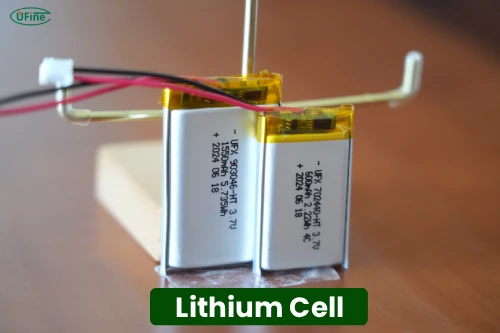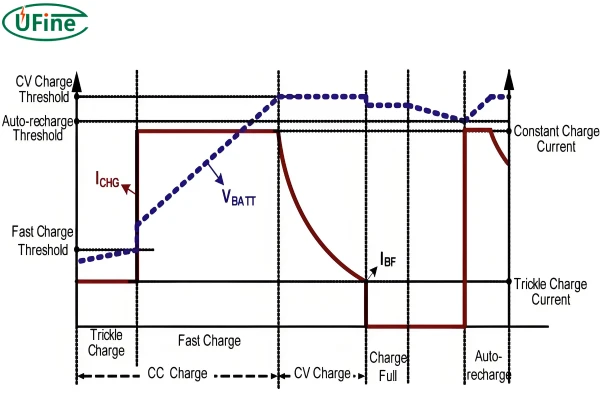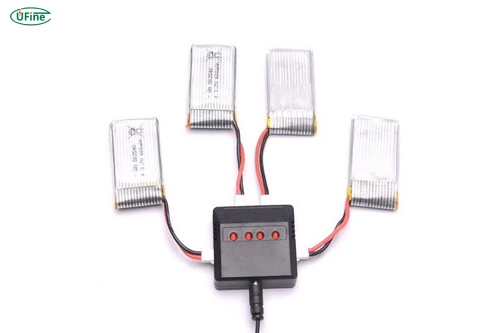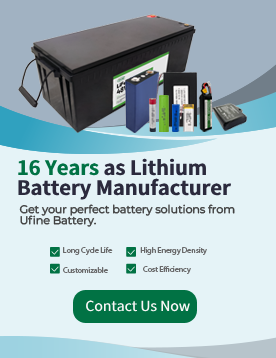
- Part 1. Understanding lithium cell chemistry
- Part 2. How charging works: The CC/CV process explained
- Part 3. Recommended charging parameters for lithium cells
- Part 4. Choosing the right lithium cell charger
- Part 5. Charging environment and safety conditions
- Part 6. Charging methods: standard vs. fast charging
- Part 7. Balancing and multi-cell charging
- Part 8. Common charging mistakes to avoid
- Part 9. How to tell if a lithium cell is fully charged
- Part 10. Storage and maintenance after charging
- Part 11. Charging lithium cells in different applications
- Part 12. Safety features and protective technologies
Part 1. Understanding lithium cell chemistry
To understand why charging matters so much, let’s start with how a lithium cell works.
A typical lithium-ion cell consists of:
- Anode (negative electrode) — usually made of graphite.
- Cathode (positive electrode) — made from compounds like lithium cobalt oxide or lithium iron phosphate.
- Electrolyte — a lithium salt in a solvent that allows ions to move between electrodes.
- Separator — prevents short-circuiting while allowing ion flow.
Learn About the Cathode and Anode of the Battery
When charging, lithium ions move from the cathode to the anode and store energy in the process. During discharge, the ions move back, releasing energy to power your device.
This reversible ion movement is highly efficient but sensitive to voltage and temperature. Overcharging or charging at improper voltages can destabilize the chemical structure and lead to overheating or even cell failure.
Different lithium chemistries — such as Li-ion, LiPo (lithium polymer), and LiFePO₄ (lithium iron phosphate) — have distinct voltage limits and charging requirements. Always check your battery type before selecting a charger.
Part 2. How charging works: The CC/CV process explained
Charging lithium cells isn’t as simple as plugging in and waiting. It follows a precise two-stage process known as CC/CV — Constant Current / Constant Voltage.
Stage 1: Constant Current (CC)
- The charger supplies a steady current (usually 0.5C–1C, where C is the cell’s capacity).
- The voltage gradually increases as the battery charges.
- This phase continues until the cell reaches its maximum safe voltage (typically 4.2V per cell for Li-ion).
Stage 2: Constant Voltage (CV)
- Once the voltage limit is reached, the charger holds the voltage constant.
- The current gradually tapers off as the cell approaches full capacity.
- Charging stops when the current drops below a cutoff threshold (usually around 3%–5% of rated current).
This method prevents overcharging and ensures efficient energy absorption without stressing the battery.
For instance, a 3.7V Li-ion cell typically follows a CC/CV charge profile up to 4.2V ± 0.05V. LiFePO₄ cells, on the other hand, charge up to 3.6V ± 0.05V per cell.
Part 3. Recommended charging parameters for lithium cells
Charging lithium cells safely requires following strict voltage and current guidelines. These vary depending on cell chemistry:
| Battery Type | Nominal Voltage | Max Charge Voltage | Typical Charge Current |
|---|---|---|---|
| Li-ion (18650) | 3.6–3.7V | 4.2V | 0.5C–1C |
| LiPo | 3.7V | 4.2V | 0.5C |
| LiFePO₄ | 3.2V | 3.6V | 0.5C–1C |
⚠️ Never exceed these voltage limits — even small overvoltages can cause gas buildup, swelling, or thermal runaway.
Ufine Battery engineers emphasize that each lithium cell model undergoes strict voltage calibration and quality testing to ensure stable charging performance. Whether you’re using small cylindrical cells or custom battery packs, always refer to the manufacturer’s recommended parameters.
Part 4. Choosing the right lithium cell charger
A lithium battery charger is not the same as a typical NiMH or lead-acid charger. Lithium cells demand precise control to prevent overvoltage and current spikes.
Key features of a good lithium charger:
- Constant Current / Constant Voltage control.
- Automatic cutoff when the charge current drops below threshold.
- Overvoltage and overcurrent protection.
- Temperature monitoring (optional for larger packs).
Smart chargers include built-in microcontrollers that dynamically regulate voltage and current, ensuring optimal charge termination.
If you’re charging multi-cell packs, choose a charger compatible with your battery configuration (e.g., 3S, 4S, 6S) and equipped with balancing connectors.
Part 5. Charging environment and safety conditions
The environment where you charge your lithium cells plays a huge role in performance and safety.
Ideal charging conditions:
- Temperature: Between 0°C and 45°C (32°F–113°F).
- Humidity: Below 85% RH, with good ventilation.
- Surface: Non-flammable, stable surface away from direct sunlight or heat sources.
Charging below 0°C may lead to lithium plating — metallic lithium forming on the anode, which can cause short circuits later. Charging above 45°C increases internal pressure and accelerates chemical breakdown.
Always charge in a fire-safe location and avoid covering the battery with fabric or insulation while charging.
Part 6. Charging methods: standard vs. fast charging
Fast charging is convenient — but it’s not always the best for lithium cells.
Standard Charging
- Uses 0.5C to 1C current.
- Preserves cell longevity and maintains stable temperature.
- Recommended for everyday charging cycles.
Fast Charging
- Involves 1.5C–2C or higher current.
- Reduces charging time significantly but increases heat and internal stress.
- Should only be used if the cell is designed for fast charge (check manufacturer’s rating).
Note: Ufine Battery’s R&D team has developed high-rate lithium batteries optimized for faster charging without overheating, making them ideal for high-performance applications like drones and portable power tools.
Still, for most users, standard charging remains the safest and most battery-friendly option.
Part 7. Balancing and multi-cell charging
When charging packs with multiple lithium cells connected in series (like 3S, 4S, 6S packs), it’s essential to keep each cell at the same voltage level — a process known as cell balancing.
Even small differences between cells can lead to:
- Overcharging of one cell while others remain undercharged.
- Reduced total capacity.
- Safety risks due to imbalance.
How balancing works:
- Passive balancing: Extra voltage from higher cells is dissipated as heat.
- Active balancing: Transfers energy from higher-voltage cells to lower ones, improving efficiency.
Balancing is typically managed by the Battery Management System (BMS), which continuously monitors cell voltage and ensures uniform charging.
Part 8. Common charging mistakes to avoid
Even experienced users make errors that can drastically shorten battery life or cause damage. Here are the top mistakes to avoid when charging lithium cells:
1. Using the wrong charger:
Not all chargers are compatible with lithium cells — mismatched voltage can cause irreversible damage.
2. Charging unattended:
Always keep batteries within sight during charging, especially high-capacity ones.
3. Overcharging:
Leaving a battery connected after it’s full can cause stress and swelling over time.
4. Charging in high temperatures:
Heat accelerates electrolyte breakdown, leading to capacity loss.
5. Charging damaged or swollen batteries:
These can short-circuit or ignite. Dispose of them safely instead.
By following correct procedures and avoiding these mistakes, you ensure not only safety but also long-term performance.
Part 9. How to tell if a lithium cell is fully charged
A lithium cell’s voltage is the most reliable indicator of its charge status.
- Fully charged (Li-ion): 4.2V per cell
- Fully charged (LiFePO₄): 3.6V per cell
- Nominal (mid-charge): 3.6–3.7V
- Discharged: Around 3.0V
Most smart chargers automatically stop charging once the cutoff voltage is reached and the current drops below 0.05C.
Avoid “topping off” batteries unnecessarily — once fully charged, disconnect the charger. Continuous trickle charging can stress lithium cells, unlike NiMH or lead-acid types that tolerate float charging.
Part 10. Storage and maintenance after charging
Proper storage habits are vital to keeping lithium cells healthy for years.
Best storage practices:
- Charge level for storage: 40%–60% (around 3.7–3.8V per cell).
- Temperature: Cool, dry place (around 15°C–25°C).
- Avoid full charge storage: Keeping batteries at 100% for long periods speeds up aging.
- Recharge every 3–6 months to prevent deep discharge.
If your device will remain unused for months, partially charge the battery and store it separately.
Part 11. Charging lithium cells in different applications
The correct charging method also depends on the type of application and battery setup.
Consumer Electronics
Devices like smartphones, tablets, and cameras typically use built-in BMS with USB-based smart charging. The system automatically controls voltage and temperature.
Drones and RC Devices
These use high-drain lithium polymer (LiPo) batteries. They require balance chargers and should never be charged unattended.
Electric Vehicles (EVs)
EVs rely on complex multi-cell systems managed by high-precision BMS units. Charging stations use algorithms to balance performance, heat, and lifespan.
Energy Storage Systems
Large-scale lithium packs use smart charging protocols that adjust dynamically based on temperature and state of charge.
Ufine Battery provides custom lithium battery packs for each of these applications, ensuring compatible charging parameters and integrated protection circuits.
Part 12. Safety features and protective technologies
To make charging lithium cells safer, modern chargers and battery packs include multiple layers of protection:
- Overvoltage Protection: Prevents voltage from exceeding limits.
- Overcurrent Protection: Stops charging if current exceeds safe levels.
- Temperature Sensors: Cuts off charging when overheating is detected.
- Short-Circuit Protection: Prevents damage in case of wiring failure.
Additionally, some lithium cells include built-in Protection Circuit Modules (PCM) for individual cell safety — particularly in consumer electronics.
Related Tags:
More Articles
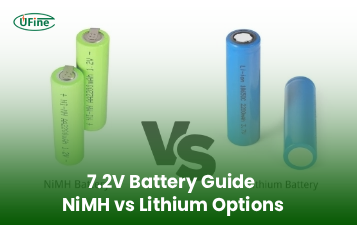
NiMH vs Lithium 7.2V Battery and Charger: Which Is Better?
Compare 7.2V NiMH vs Lithium batteries and chargers in 2025. Learn runtime, weight, charging, lifespan, and cost to choose the best for your device.
How to Choose the Right 7.2V Battery and Charger for Your Device?
Learn how to choose the right 7.2V battery and charger for optimal performance, safety, and longevity across RC, tools, medical, and industrial devices.
Big Square Battery Safety Standards You Must Know
Learn key safety standards for big square batteries to avoid fire risks, shipping delays, and compliance issues in EV, industrial, and energy storage projects.
Big Square Battery Applications in Solar & Industrial Equipment
Big square batteries deliver high capacity, stable output, and long life for solar, industrial, and backup power. Explore key uses and advantages.
Big Square Battery vs Cylindrical Battery: Complete 2025 Guide for EVs, ESS & Industrial Devices
Choosing the right battery is key for designers and engineers. Compare big square vs cylindrical batteries to find the best fit for your application.
